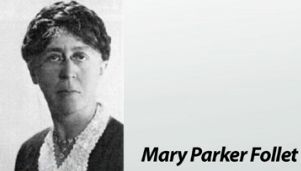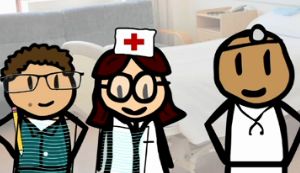Mary Parker Follett: People-Oriented, Group-Network Management - Answers
The answers are in BOLD below.
NOTE: The transcript from the video is listed below the quiz for your reference.
1. Mary Parker Follett talked about management and employees working together to make decisions. This became known today as:
- Situational leadership
- Autocratic leadership
- Participative leadership
- Bureaucratic leadership
- Authoritarian leadership
2. People-orientation involves
- treating customers as people
- treating suppliers as people
- treating managers like people
- involving employees in decision making
- treating patients as people
3. The result(s) of group interactions are:
- better communication
- mutually beneficial relationships
- better decision making
- participation in organizational achievements
- all answer choices are correct
4. Group networking means:
- meeting people outside the company for a meeting
- meeting with people inside the company to work on a single project
- working with people inside the company on different projects that contribute to the organizational objectives
- working with people in other companies on similar projects
- working with a small group with no shared information
5. When a top-manager asked his employees to help him to come up with new prices for their products, he was using a
- group networking approach
- people-oriented approach
- pricing strategy
- conversational questioning
- giving orders
Leaders in today's organizations utilize common goals and participative decision-making to achieve a people-oriented, group network management approach. Mary Parker Follet developed this classical leadership theory during the pre-war 1920s, and it is still relevant in contemporary business.
People Orientation and Group Network Management
When Mary Parker Follet, a social worker and management consultant, talked about issues like the importance of people-oriented, group network management through group interaction and shared power between managers and employees in business, she was actually pioneering the notion of participative leadership. Participative leadership involves managers and employees working together towards common goals like decision-making and problem-solving. Managers participate in decisions and support employees with resources needed to accomplish goals.
 |
When Smitty broke his leg and needed surgery, he knew he would have to visit many different treatment facilities. Getting appointments with a general doctor, a surgeon, a physical therapist, a social worker and maybe even a plastic surgeon could be a lengthy and tedious process. Smitty made hundreds of phone calls to individual practitioners only to find the process difficult to manage. He decided to use One-Stop Medical Associates for all of his treatment and care because of the team approach they take to caring for patients.
 |
One-Stop uses people-oriented management. People-oriented management is a participative leadership style that involves including employees in making important company decisions by equally balancing leader and employee power. This orientation toward shared power and ownership of responsibility makes resolving conflict much easier.
On his first visit, the team examined Smitty's leg and documented his file. Then they met in a conference room to discuss the steps they will take to treat the patient. The doctor and surgeon talk about their responsibilities. The nurse coordinates with the doctors on her responsibilities, and the social worker writes her treatment plan. Once the plans are finished, group decisions are made.
- Surgeon performs the surgery
- General doctor prescribes medicines and monitors patient progress
- Nurse changes bandages and takes blood pressure
- Social worker eases patient's anxieties
As treatment is provided, the group shares information on the patient's current state and his progress towards recovery. Each detail is discussed and used to make decisions about future treatments. Although each practitioner has their own area of specialization, as a team, they are able to make contributions about the whole treatment plan rather than just their own individual specialties.
 |
One-Stop also uses a group network management approach to achieve their goals. A group network management approach involves groups of people within the organization with equal power over outcomes. These groups work on separate parts of an organization, and each group contributes pieces together to achieve one organizational goal.
One-Stop Medical balances the power between management and the practitioners. Top management rarely deals with patients, but they are responsible for the achievement of overall objectives, like being profitable and providing premium healthcare. Top brass at One-Stop involve the employees in decisions about patient care, records management and staffing. They also hold employees accountable for their decisions.
Both people-oriented management and group network management involve small groups working together to meet overall objectives. It is done through group interactions.
Group Interactions
When decisions are made as a group, each employee feels a stronger commitment to the outcomes. One-Stop Medical uses group decision-making for total patient care. Each patient is assigned to a team of different employees. Smitty's general doctor, surgeon, nurse, social worker and physical therapist discuss his treatment outcomes with each other. These conversations are known as group interactions.
 |
Group interactions occur when there is positive collaboration between employees who are socially attracted to one another, have shared goals and have a unique identity that sets them apart from others in the organization. They lead to:
- Greater communication
- Mutually beneficial relationship building
- Better decision-making
- Participation in organizational achievements
When employees and management communicate their ideas, they develop relationships that benefit themselves and the overall organization. Better decisions come from more minds.
 |
Lesson Summary
Mary Parker Follet was a social worker and management consultant who talked about issues like the importance of people-oriented, group network management through group interaction and shared power between managers and employees in business. This evolved to become a form of participative leadership.
People-oriented management is a participative leadership style that involves including employees in making important company decisions by equally balancing leader and employee power. This orientation towards shared power and ownership of responsibility makes resolving conflicts much easier.
Group networking is also participative in that it involves groups of people within the organization with equal power over outcomes. These groups work on separate parts of an organization, and each group contributes pieces together to achieve one organizational goal.
Both people-orientation and group network management involve working in groups to achieve common goals. Groups use a form of communication known as group interactions. These interactions are positive collaboration between employees who are socially attracted to one another, have shared goals and have a unique identity that sets them apart from others in the organization. They lead to good communication needed for better decision-making.